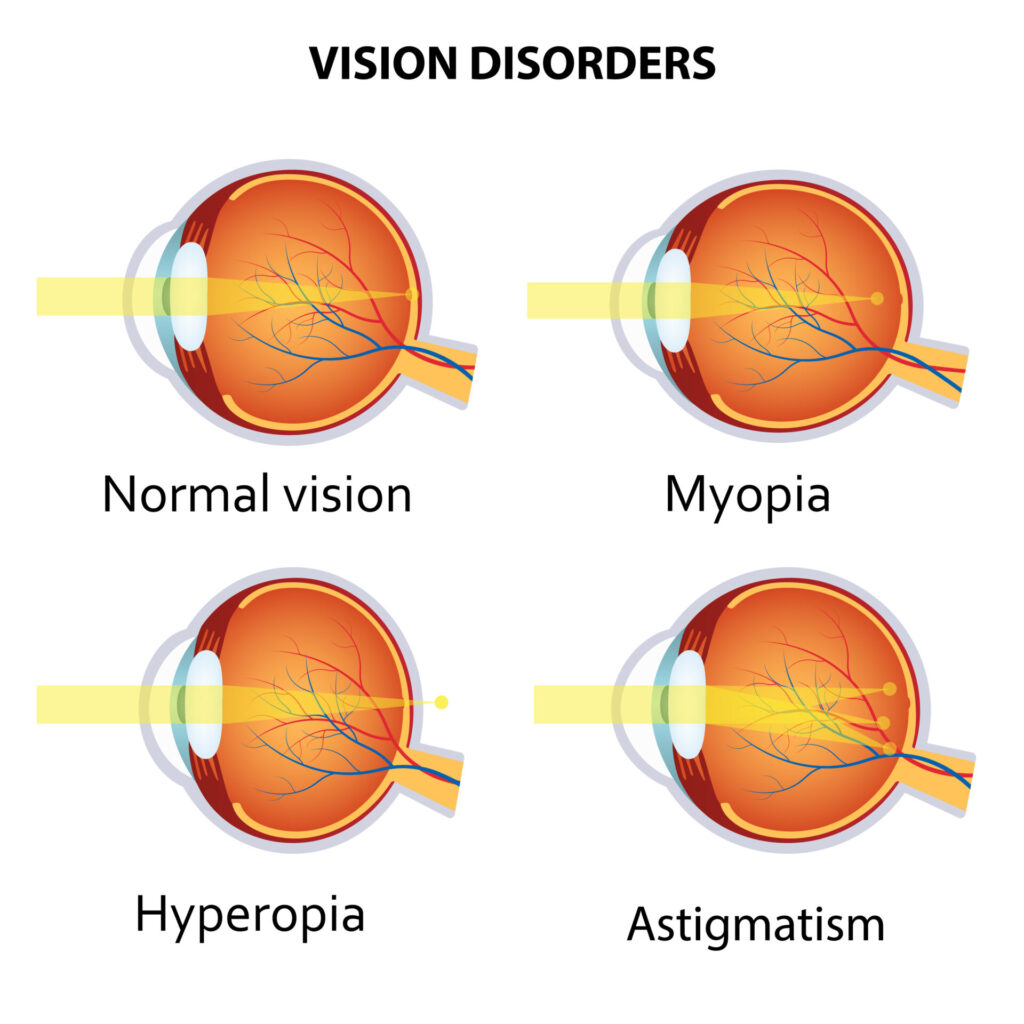Did you know that about 25% of all children need vision treatment? Did you also know that many of these kids have a vision issue that goes unnoticed? Until the eyesight becomes noticeably bad, the average child likely does not realize the severity of their vision problem. They assume they see the same as everyone else. After correction or treatment, they’ll realize just how off their sight has been.
Your child’s vision is crucial to their development and education. Let’s look at three eye issues that are common to children but can go unnoticed
Refractive Issues

The most common vision problems among children are refractive errors, most specifically:
Astigmatism
Astigmatism is a refractive error that occurs when the cornea’s curve begins to warp. In normal eyes, the cornea is round and spherical, much like a ping pong ball. But, the cornea can develop an oval-like shape vertically (like an egg) or horizontally (like a rugby ball) and create sight problems.
In a perfect eye, light hits the retina at one point, allowing the brain to receive one clear image. In children with astigmatism, light hits the retina in more than one place, causing objects at any distance to either appear doubled, shadowy, or overall blurry.
Astigmatism can be a challenging vision issue to catch without routine eye exams. For some, the error is minor enough not to notice. But even so, with corrective lenses, your child can tell a clear difference between their natural vision and their corrected vision.
Common signs of astigmatism include:
- Blurry or distorted vision
- Eyestrain
- Frequent headaches
- Fatigue
Myopia
Myopia, or nearsightedness, is a refractive error wherein the eye either protrudes outward too much or the lens becomes too curved and causes the point of light to not quite reach the retina. As a result, the child’s vision beyond what is directly in front of them becomes blurry.
Common warning signs include your child struggling to see:
- The classroom board
- A movie screen
- The television
- Action on the field
Squinting and eye strain are also common issues with myopic patients and can signal that your child needs an eye exam.
Even the way your child reads a book could point to myopia. Does your child hold the book in their lap or close to their face? If it’s up close, it’s wise to consider scheduling an eye appointment.
Hyperopia
Hyperopia, or farsightedness, is the opposite of nearsightedness in that objects up close appear blurry, and objects at a distance appear clear. It occurs when either the eyeball’s curve is flatter than it should be, the cornea has less of a curve, or the lens is too thin, causing the point of light to focus behind the retina.
Common warning signs that your child has developed hyperopia include:
- Trouble reading books
- Difficulty writing or using the computer
- Squinting and eye strain
- Trouble playing with toys
Strabismus
Strabismus is a condition where one or both eyes are not properly aligned, causing them to turn either:
- In – clinically called esotropia, commonly called “cross-eyed”
- Out—clinically called exotropia, commonly called “wall-eyed”
- Up—clinically called hypertropia
- Down–clinically called hypotropia
Children with strabismus have either one or both eyes that cannot maintain alignment. Typically, one eye is stronger than the other and can focus on an object while the other eye cannot.
Common causes of strabismus include:
- Amblyopia
- Binocular vision dysfunction
- Muscle weakness in the eye
- Neurological complications
- Severe refractive issues
- Trauma to the head
If your child has or develops strabismus, it is treatable with the right therapies and vision treatments.
Amblyopia
Amblyopia, more commonly known as lazy eye, occurs when one eye develops less strong or functional than the other eye. In rare cases, both eyes can develop weakly and become “lazy.”
The weaker eye will develop blurry vision, and your child can experience complications like:
- Depth perception issues
- Focusing trouble
- Vision loss
In many cases, amblyopia is a slowly developing issue, and neither the child nor their parents notice it in the early stages. However, there are some warning signs that can point to its development:
- Squinting or shutting one eye
- Frequent eye rubbing
- Poor depth perception
- Poor hand-eye coordination
- Focusing difficulties
- Problems with tracking objects
- Eyes or one eye that seems a little off
Amblyopia’s root cause is neurological and occurs because of miscommunication between the brain and the eye. The pathways that visual signals and brain signals use are disconnected somehow, causing less communication and resulting in the weakening of the eye or eyes.
Because amblyopia can be difficult to catch at first, it is crucial to maintain routine eye exams for your child. If caught early enough, vision therapy can help strengthen a lazy eye and train the eyes to work together, preventing further amblyopia-related vision issues from developing.
Catch Your Child’s Vision Problems Early Through Regular Eye Checkups with Vision Eye Group’s Optometrists and Ophthalmologists.
To set your child up for success in the classroom and the everyday world, maintain regular eye exams with any of our trusted eye care providers. We will check your child’s eyes and provide any necessary corrective lenses or treatments your child may need. We also offer referrals to reliable vision therapists or other needed professionals. Schedule your child’s eye exam today by calling 478-744-1710.
Related Articles
